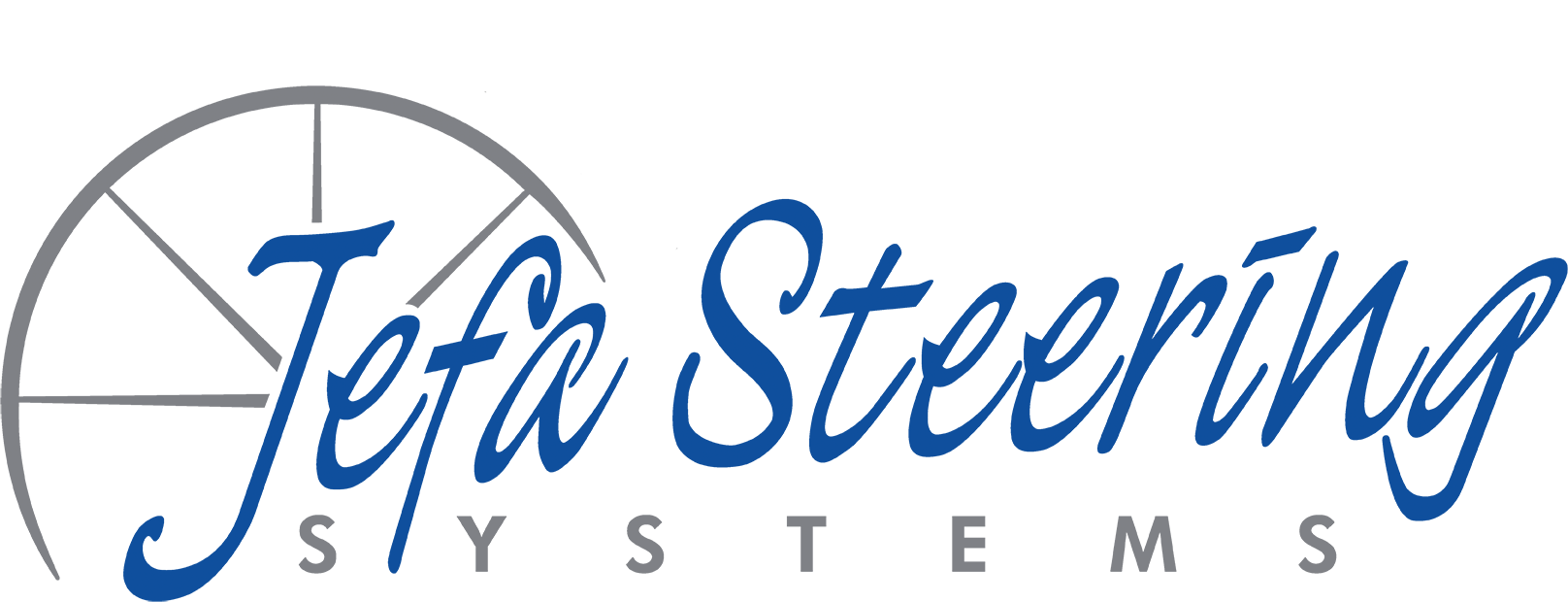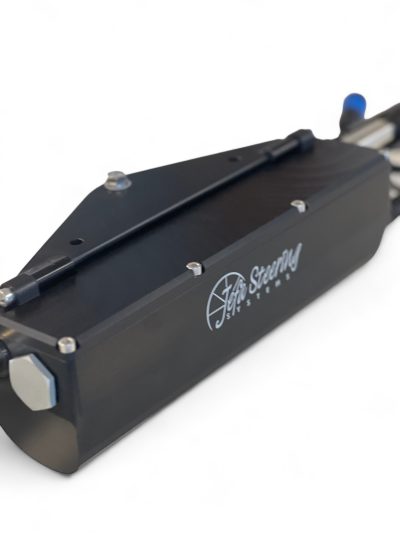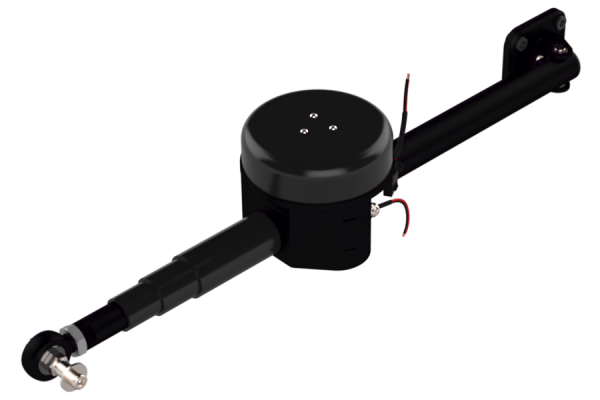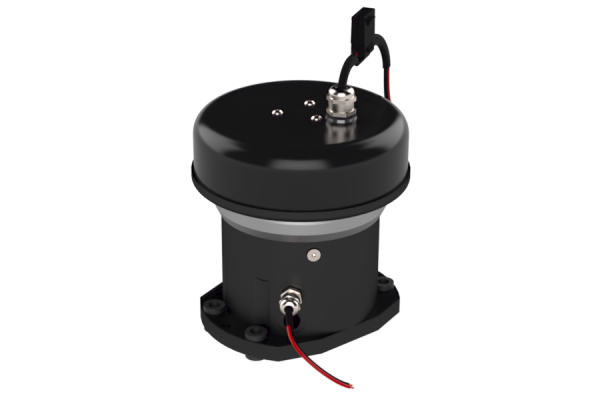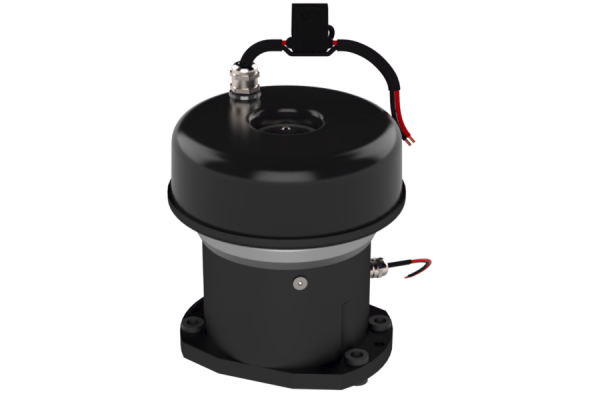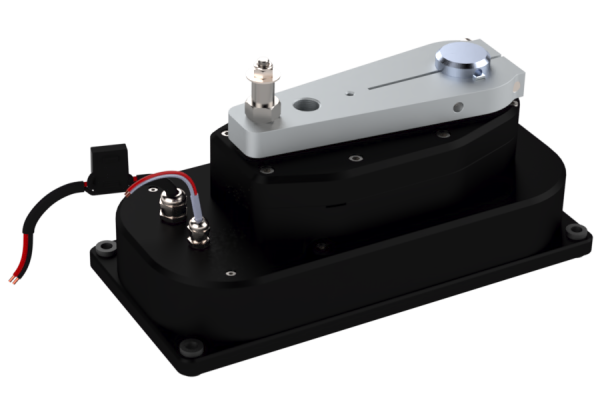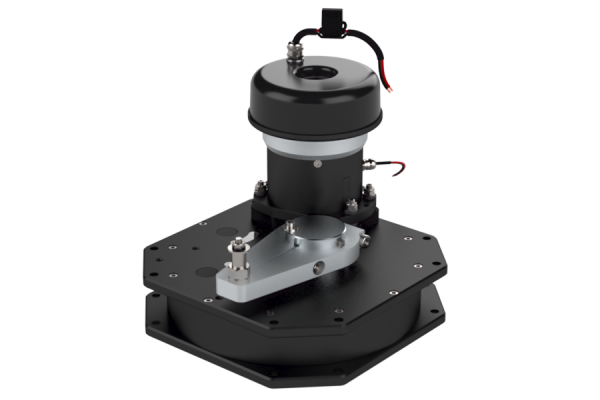Transmission drive unit 300 Nm 24 volts (40′ to 90′)
The Jefa transmission drive is one of the most compact autopilot drives in the world. It’s as strong as a human being (the max. output torque of 300 Nm is equivalent to 60 Kg on the rim of a 1 meter wheel) and is build for 24 hours per day continuous operation with a total weight of only 6 Kgs. The combination of the specially designed electric motor with the ultra efficient 3 stage planetary gearbox results in an extremely efficient drive unit to keep the battery charging time to the minimum. The drive can be used on boats from 40 to 90 foot (or with a rudder torque up to 950 KgM) equipped with a Jefa transmission steering system.
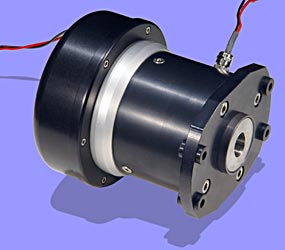
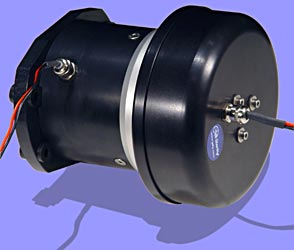
Main dimensions
The Jefa transmission drive is very compact with a length of 169 mm and a maximum diameter of 161 mm. As space is always a problem on sailing yachts, the compact drive unit can be integrated into the steering system even when a very limited space is available. The drive can be mounted on the BG11 and BG14 bevel gearboxes or directly on the RG10 reduction gearboxes. Please remind that a preparation for the autopilot integration is required when ordering the steering system.
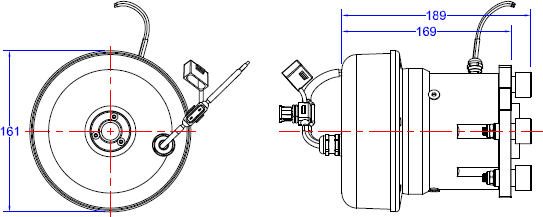
The mounting possibilities:
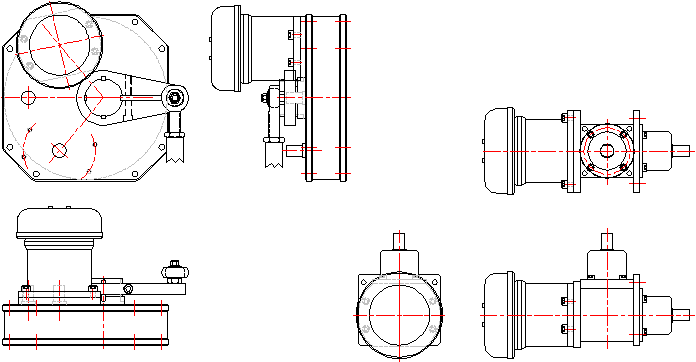
The transmission drive can be mounted on every (prepared) bevel gearbox in the steering system or directly on the RG type reduction boxes with multiple input shafts.
The construction:
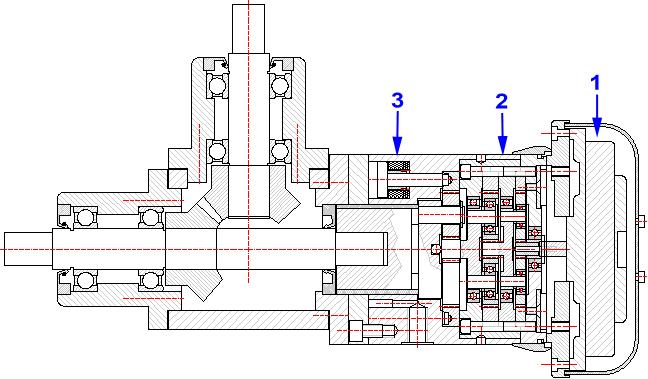
The above assembly drawing shows a transmission drive mounted on a bevel gearbox. The drive can be separated in 3 main parts: The electric motor (1), the three stage planetary gearbox (2) and the electro-magnetic clutch (3). The Jefa transmission drive has multiple advantages over existing integrated drive units. These advantages will be explained per section of the drive:
Electric Motor: The flat wound electric motor used in the Jefa drive units is not a standard industrial motor, but specially designed and produced for this application. This solution is more expensive but there are multiple advantages over standard industrial motors.
- The collector (1) is extremely big so a large contact surface of the coal brushes is achieved. The result of this is a very high efficiency under heavy load and a very small drop in speed at the maximum torque. (Only 25% loss of speed at full load compared to a stall situation (zero speed) with other brands of autopilot drives).
- The central motor shaft runs in ball bearings in stead of gliding bearings. This results in a higher efficiency, less noise and a much longer life time.
- A large flat wound rotor to achieve a high starting toque and an immediate response to the autopilot speed control signal.
- Specially produced magnets with an extremely long lifetime and field strength. (Normal magnets can loose up to 50% field strength over a couple of years).
- Exchangeable coal brushes to guarantee an infinite lifetime of the drive.
Aluminium motor housing in stead of sheet steel plate to avoid corrosion.
Planetary gearbox: To achieve a correct rudder travel speed (hard over time) the electric motor has to be reduced in speed with a factor 486:1. Some autopilot drive producers use a worm reduction box, but the efficiency is extremely low as the gears rub each other. Some producers use a combination of a planetary gearbox with a 2 stage spur gear set (one small gear and one big gear), but this creates a much bigger unit with an offset to the centre and much heavier loaded gears. The best way to achieve this high reduction in combination with a high torque is a 3 stage planetary gearbox. It’s also the most expensive way as every gear step has 4 gears in stead of 2 gears but the huge advantages overrule the higher price:
- The highest possible efficiency compared to any other gearbox.
- All forces are equally spread over 3 gear teeth in stead of one allowing a much compacter and stronger solution.
- The forces and torques from the motor to the output shaft remain in the centre line of the drive unit, resulting in a higher efficiency and extremely reduces the loads on the housing and other internal parts.
Electro magnetic clutch: On the moment the transmission steering system on the yacht is manually operated, the autopilot drive has to be disconnected from the steering system. This is achieved with the electro-magnetic clutch (4) and controlled automatically by the autopilot junction box. Jefa has developed a unique and patented engagement clutch. The solution is based on two electrically operated spring loaded clutch pins that engage and disengage the outer gear ring of last planetary gear step. This solution has multiple advantages over the existing friction plate clutches:
- Less friction to back drive the unit.
- Lower power consumption (0.7 Amp at 24 Volt). When the clutch isn’t powered, it’s disengaged and engaged when powered.
- The clutch doesn’t wear in time.
- More compact than any friction clutch.
- When the autopilot is switched off, the helmsman isn’t suddenly confronted with the full rudder torque, but has to put loading on the wheel to equalize the forces so the the clutch can disengage, making the manual take over much safer.
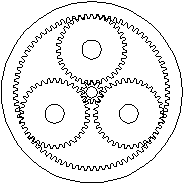
300 Nm transmission drive DU-TS6-24 performance table: (in combination with the 1:7 reduction box RG10-70)
DATA TABLE
| rudder torque | rudder torque | power | rudder rotation | time for |
|---|---|---|---|---|
| full rudder | midschips | usage | per second | 72° rudder |
| (KgM) | (KgM) | (amps) | (degrees/sec.) | (sec) |
| 145 | 73 | 2 | 3:06 | 20 |
| 182 | 364 | 5 | 3:02 | 23 |
| 291 | 582 | 8:05 | 2:09 | 25 |
Connections:
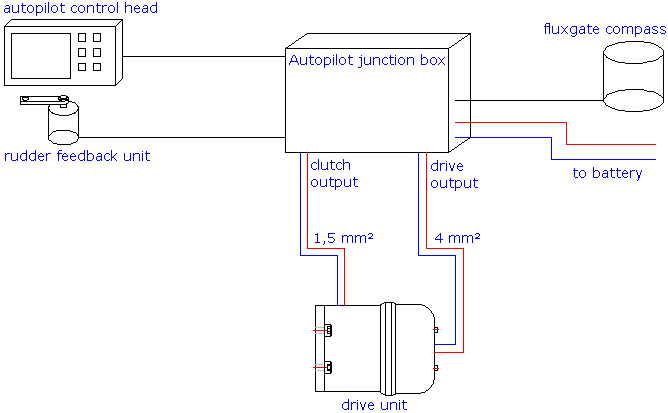
This illustration shows the minimal components for a working autopilot configuration. Jefa autopilot drives work together with all mayor autopilot electronics. The connection of the Jefa autopilot drive to the autopilot junction box is quite simple. The two 1.5 mm² red and black wires have to be connected to the plus and minus of the autopilot clutch line. This will make sure that when the autopilot user engages the autopilot on the control screen, the clutch will engage and allow the autopilot motor to drive the steering system. The two 4 mm² red and black wires have to be connected to the autopilot drive output connection. Now the Jefa autopilot drive is integrated into the system.
Special Whitlock/Lewmar connector:
The Jefa transmission drive unit is available with a special front end so it can be fitted to existing Whitlock/Lewmar transmission systems using the 3/4″ (19.22 mm) 48 teeth splined shaft. Please order extra code DU-TS-LEW.
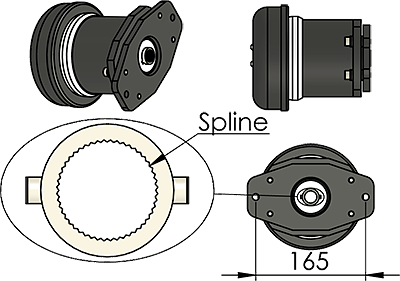
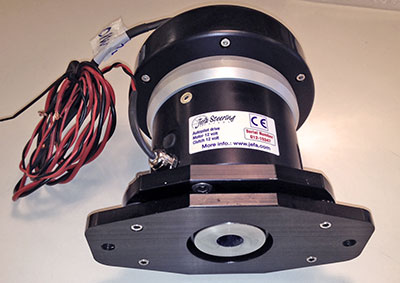
Compatibility in 24 Volts
Following table shows the maximum rudder torques at midships and full rudder that can be generated by the Jefa 300 Nm transmission drive in combination with various autopilot junction boxes and reduction gearboxes. As the transmission drive drives the steering system, the maximum rudder torque depends on the type of reduction box used in the system. The hard over time (HO-time) states the time it takes the drive to travel the full 72 degrees of rudder travel when the speed control of the pilot is set to maximum speed.
DATA TABLE
| Autopilot junction box 24 Volt version. | Max. output (Amp.) | RG10-70 midships (KgM) | RG10-70 full rudder (KgM) | BRG10-67 midships (KgM) | BRG10-67 full rudder (KgM) | RG10-100 midships (KgM) | RG10-100 full rudder (KgM) |
|---|---|---|---|---|---|---|---|
| DU-TS6-24 | 6.5 revs/min | 19 sec. | 18 sec. | 27 sec. | |||
| Garmin GHP12 sailboat APS (*1) | 40 | 169 | 321 | 237 | 449 | 226 | 430 |
| Simrad AC12 | 12 | 169 | 321 | 237 | 449 | 226 | 430 |
| Simrad AC42 | 30 | 169 | 321 | 237 | 449 | 226 | 430 |
| Raymarine ACU-200 (*2) | 15 | 169 | 321 | 237 | 449 | 226 | 430 |
| Raymarine ACU-400(*2) | 30 | 169 | 321 | 237 | 449 | 226 | 430 |
| Furuno Navpilot | not advisable due to lack in speed control and dynamic braking see this page | ||||||
| B&G H5000 Pilot (*3) | 30 | 169 | 321 | 237 | 449 | 226 | 430 |
| B&G Triton Pilot - Low Current | same as Simrad AC12 - see above | ||||||
| B&G Triton Pilot - High Current | same as Simrad AC42 - see above |
(*1)) A special Garmin version of the transmission drive is available with extra codes DU-CD-RFB & DU-CAB-G. The Garmin rudder feedback unit is integrated and special Garmin cables and plugs are wired to the drive unit. Please note the maximum revolutions of the output shaft of the drive should not exceed 2,5 turns for the rudder feedback unit to work properly. See below pricelist for the surcharge.
(*2) An internal rudder feedback unit is available for this pilot which saves installation time and a separate fundament for the external rudder feedback is not required. See below pricelist for the surcharge. Please note the maximum revolutions of the output shaft of the drive should not exceed 2,5 turns for the rudder feedback unit to work properly. See below pricelist for the surcharge.
(*3) From software release 1.1.84 onwards. Older H5000 pilots should be software upgraded. For a complete list of compatible B&G autopilots please follow this link.
DATA TABLE
Jefa transmission drive units
| Part No. | Description |
|---|---|
| DU-TS6-24 | Transmission autopilot drive unit 300 Nm 24 Volts - 6.5 rev/min |
| DU-TS-RFB1 | TS integrated rudder feedback for Garmin and NKE autopilots (10 kΩ)*¹ |
| DU-TS-RFB2 | TS integrated rudder feedback for Raymarine autopilots (5 kΩ)*¹ |
| DU-TS-RFB3 | TS integrated rudder feedback for B&G (NAC-2) autopilots (5 kΩ)*¹ |
| DU-CAB-G | Garmin cables and plugs mounted to drive units |
| DU-TS-LEW | Adapter for Whitlock/Lewmar autopilot flange |
Art. 11719
